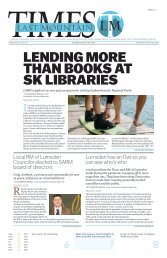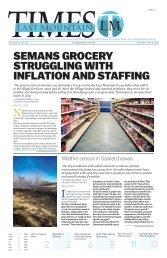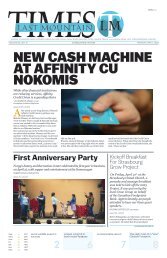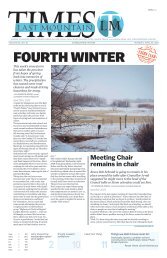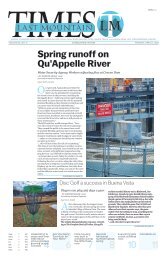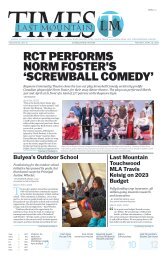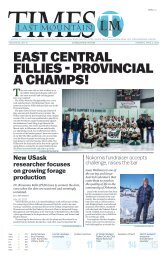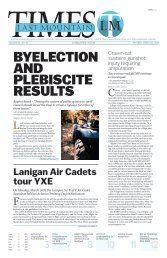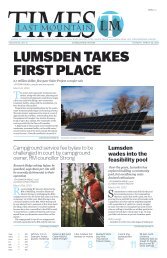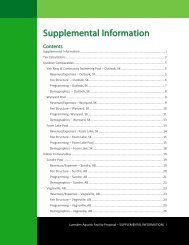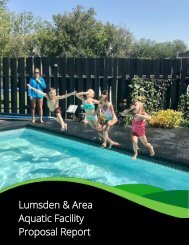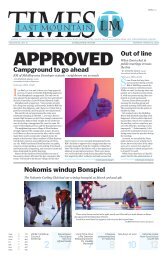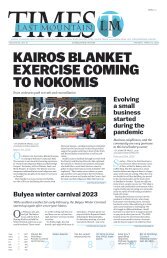LMT May 7 April
Create successful ePaper yourself
Turn your PDF publications into a flip-book with our unique Google optimized e-Paper software.
Monday, <strong>May</strong> 7, 2018 • Last Mountain Times<br />
13<br />
CONTINUED from PAGE 2<br />
nificant meandering of the Qu’Appelle River is very<br />
obvious! From Regina, trace Highway #6 north<br />
going to the Valley, and then crossing it on the way<br />
to Southey. Just below the Fairy Hill area and East<br />
is the Piapot First Nation. The natural grooves in<br />
Mother Earth are the significant evidence carved,<br />
and re-carved by the immense amount of meltwater<br />
from the last glacial period about 13,000 years ago,<br />
and previous ones. These grooves creating ravines/<br />
coulees are like the “capillaries and veins” of Earth’s<br />
circulatory system returning the water and other<br />
harmful stuff to the oceans. Note Condie Nature<br />
Refuge, and the various local Creeks in the left half<br />
of the photo. See some of Valeport Marsh above<br />
Craven which really is part of another major glacial<br />
drainage channel - the bottom end of Last Mountain<br />
Lake. Multiple little side streams/creeks can be<br />
seen. Near the bottom right and in the top right, see<br />
the remnants of poplar tree bluffs that haven’t been<br />
torn down to create more agricultural cropland.<br />
There is much more that can be interpreted from an<br />
enlarged, actual photo, or on the computer screen.<br />
Can you pick out the speck where you live?<br />
Because they’ve been to space, all astronauts have<br />
a different perspective on life and living. Check<br />
these books by two Canadian astronauts: Roberta<br />
Bondar’s Touching the Earth (1992), and Chris Hadfield’s<br />
You Are Here (2014). Chris’s photographs are<br />
also featured in a recent book (2013) by Magic Light<br />
Publishing of Ottawa called Earth: Spirit of Place.<br />
However, the classic volume is: Kevin W. Kelley’s<br />
The Home Planet (1988) published by the Association<br />
of Space Explorers. By conceiving and editing<br />
this book, his understandings<br />
about space changed dramatically.<br />
His introduction says:<br />
“… walking on a round<br />
planet hurtling around the<br />
sun at 62,000 miles an hour<br />
[100,000 kilometers per hour/<br />
kph], turning at 1,000 miles<br />
an hour [(1,600 kph] at the<br />
Equator producing day and<br />
night. … [being aware] of our<br />
Sun as the center of the Solar<br />
System that is moving around<br />
VALLEY<br />
VIEWS<br />
BARRY MITSCHKE<br />
the Galaxy at more than 500,000 miles an hour<br />
[800,000 kph], and of the whole Galaxy itself hurtling<br />
in a direction unknown to me at an unimaginable<br />
speed through an ever-expanding universe<br />
populated with billions of other galaxies stretching<br />
to eternity. I think this sense of wonder at our universe<br />
and the strangeness of our lives within our<br />
tiny part of it is important to our sense of ourselves<br />
and perhaps to our very survival. I hope this book<br />
will help you see, and will add to your appreciation<br />
of the great beauty, the incredible wonder, and the<br />
unfathomable mystery of all this as it unfolds in the<br />
eternal moment.”<br />
We don’t feel those speeds, because we are part<br />
of them because we are part of the Earth - all is<br />
relative. But we need to appreciate that grandeur,<br />
that wonder, that beauty, and that incomprehensible<br />
mystery of where we live as human beings. This<br />
leads quickly to the spiritual and religious!<br />
(to be continued next week, in the <strong>May</strong> 7 issue)




